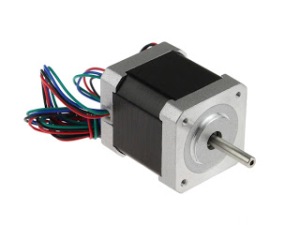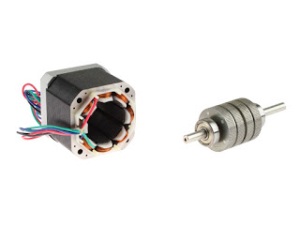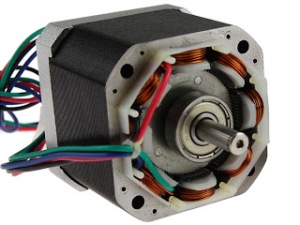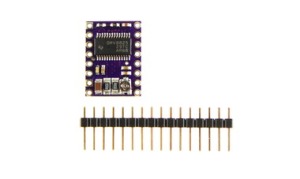A stepper motor is a special type of brushless DC motor. Electromagnetic coils are arranged around the outside of the motor. The center of the motor contains an iron or magnetic core attached to a shaft. By sequencing the voltage of the coils precise rotational control can be achieved at relatively low cost. The drawback is, the control is generally open loop, so the system does not know if the motor stalls or gets out of sync with the controller.

By creating toothed shaped coil assemblies and toothed/gear shaped rotors, very high steps counts per rotation of 200 to 400 can be achieved.

Stepper motors have a rated voltage and current. A typical stepper motor like our NEMA 17 might have a rated voltage of 2.8 Volts and a maximum current of 1.68 Amps. This basically means if you hook it up to 2.8 Volts it will draw 1.68 Amps. If you try to run it at a higher voltage it will draw more current and get excessively hot. Most people don’t hook motors straight to a voltage source. They use a stepper motor driver. Stepper motor drivers regulate the current. If you hook it up to to 12V, for example, the motor while attempt to draw more current, but the stepper motor driver will not allow that to happen and use high frequency pulses to limit the average current to the desired maximum value.

Stepper motors are designed to work this way and it is safe to run the motors at up to 20 times the rated voltage. You will actually get better performance by running at a higher voltage than the rated voltage.

Stepper motors draw power even when they are not moving, so they are generally not very power efficient. They would be a poor choice for a battery powered toy car, for example. The motors would always be drawing full power and quickly drain the battery. A standard brushed DC motor does not draw any power when not spinning and would be a better choice.
Most stepper drivers have a means to set the maximum current. It is usually done by setting a voltage at a control pin or from an on board potentiometer. The stepper driver’s maximum current assumes you are adequately cooling the driver. It is often hard, even with heatsinks to fully cool the drivers at the maximum current setting. Check your temperatures while using the machine.
Most drivers have a thermal protection feature that disables the driver for a brief period of time to allow it to cool. If you are loosing steps or hear a ticking or pulsing sound from your motors, it could be due to thermal shutdown. Try lowering the current.

If your driver is rated for less current than the motor, that is fine. You just won’t get full performance from the motor. If the driver is rated for more than the motor, you must reduce the current to the motors maximum current.
It is never a good idea to disconnect a stepper motor wire from a driver with the system powered. Many drivers are not protected from this and will be permanently destroyed.